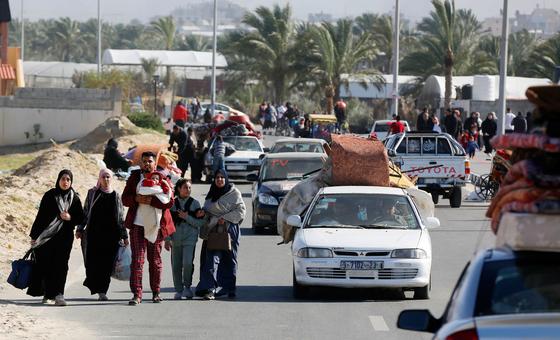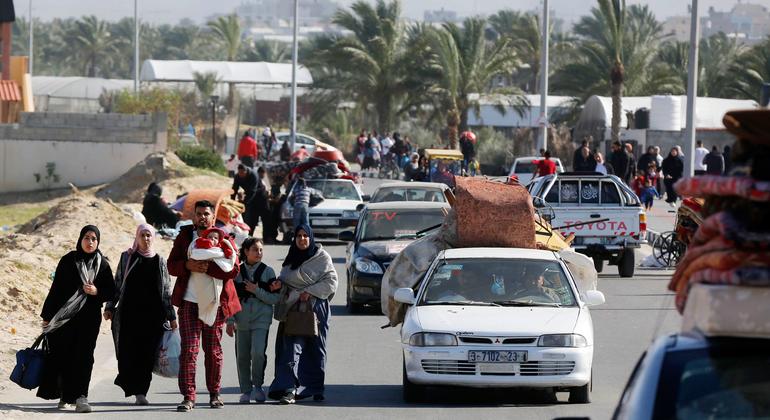
Getting enough supplies into and across Gaza now depends on the opening of new entry routes, more trucks being allowed through border checks each day, fewer restrictions on the movement of humanitarian workers, and safety guarantees for people accessing and distributing aid, they said.
They warned that humanitarian action is seriously limited by the closure of all but two border crossings in the south and the multi-layered vetting process for trucks bringing in aid.
Every hour counts
However, once inside, efforts to set up service points for people in need are hampered by bombardments and constantly shifting battlefronts, putting both ordinary Gazans and humanitarian personnel in danger.
“People in Gaza risk dying of hunger just miles from trucks filled with food,” said Cindy McCain, the WFP Executive Director.
“Every hour lost puts countless lives at risk. We can keep famine at bay but only if we can deliver sufficient supplies and have safe access to everyone in need, wherever they are.”
Famine fears
The entire population of Gaza – roughly 2.2 million people – is in crisis or worse levels of acute insecurity, the latest international food security report, IPC, has confirmed, and famine could occur if current conditions persist.
WFP has been providing food to people in Gaza since the start of hostilities on 7 October, reaching more than 900,000 in December.
The agency has had to pivot to new ways of operating with local partners, including finding safe sites for distributions, channelling wheat flour into bakeries so that they can resume production, and distributing special food supplements to help children fight off malnutrition.
Last Thursday, a WFP convoy delivered food supplies to roughly 8,000 people in north Gaza – the first since the humanitarian pause declared in November.
Young lives at risk
The ongoing conflict has also damaged or destroyed essential water, sanitation and health infrastructure and services, and limited capacity to treat severe malnutrition and infectious disease outbreaks, leaving the 335,000 children in Gaza aged five years and below especially vulnerable.
Incidence of child wasting – the most life-threatening form of malnutrition in children – could increase from pre-crisis conditions by nearly 30 per cent, affecting up to 10,000 boys and girls, according to projections by the UN Children’s Fund (UNICEF).
“Children at high risk of dying from malnutrition and disease desperately need medical treatment, clean water and sanitation services, but the conditions on the ground do not allow us to safely reach children and families in need,” said Catherine Russell, the UNICEF Executive Director.
She added that some of the material desperately needed to repair and increase water supply remain restricted from entering Gaza, putting the lives of children and their families in the balance.
Since November, UNICEF has warned that children in southern Gaza are accessing only 1.5 to 2 litres of water a day, well below the recommended amount for survival. Although the agency and partners have provided safe drinking water to over 1.3 million people, more is needed given the desperate conditions.
Medical missions
Meanwhile, WHO and partners continue supporting Gaza’s health system, including through delivering medicines, fuel, and medical equipment and supplies; coordinating emergency medical teams; and disease surveillance.
They carried out more than a dozen high-risk missions to bring supplies to hospitals in the north and south of Gaza, and helped establish two kitchens at Al-Shifa hospital, now serving 1200 meals a day.
Additionally, they delivered medical supplies to support treatment for up to 1,250 children with severe acute malnutrition, and established therapeutic feeding centres.
“People in Gaza are suffering from a lack of food, water, medicines and adequate healthcare. Famine will make an already terrible situation catastrophic because sick people are more likely to succumb to starvation and starving people are more vulnerable to disease”, said WHO Director-General Tedros Adhanom Ghebreyesus.
He stressed the need for unimpeded, safe access to deliver aid and a humanitarian ceasefire to prevent further death and suffering.
Access to Ashdod port
Israeli authorization to use a working port close to the Gaza Strip and border crossing points into the north is critically needed, the UN agencies said.
Access to Ashdod port, roughly 40 km to the north, would enable significantly larger quantities of aid to be shipped in and then trucked directly to the badly affected northern regions of Gaza, which few convoys have managed to reach.
The flow of aid into Gaza so far has been “a trickle in comparison to a sea of humanitarian needs,” said Phillipe Lazzarini, Commissioner General of UNRWA, the UN agency that assists the Palestine refuges.
“Humanitarian aid will not be enough to reverse the worsening hunger among the population. Commercial supplies are a must to allow the markets and private sector to re-open and provide an alternative to food accessibility,” he added.
The agency chiefs underlined the urgent need to lift the barriers and restrictions on aid delivery to and within Gaza, and for commercial traffic to resume, while reiterating the call for a humanitarian ceasefire.



